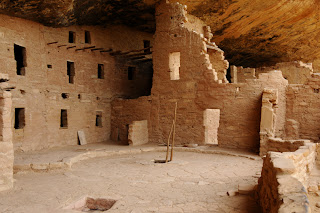 |
| Our first stop in Colorado was at the Mesa Verde RV Resort just outside of Cortez, Colorado. |
 |
| Blanche & Lucy are sitting under the Native American Dancing Eagle at the campground. |
 |
| Our campsite here was surrounded by trees for nice shade. Behind our site was a meadow with cattle grazing every day. |
 |
| Blanche & Lucy came face to face with a new friend - they were totally enthralled by the cows - never barking just staring. |
 |
| On the way to the Mesa Verde National Park we stopped to read signs that told us about the park and the ruins. |
 |
| Mesa Verde is above 7000ft elevation - the drive up to the mesa was beautiful with many pull offs to view the beauty of the valley below. |
 |
| Here are 2 more vistas of the valley below |
 |
| as we climbed to the top. |
 |
| The first place we stopped when we arrived at Mesa Verde was the Visitor's Center and the Museum with exhibits and dioramas which trace the development of the Ancestral Puebloans. |
 |
| From the first level we had a good view of the entire dwellings. Spruce Tree House is the best preserved cliff dwelling in the park. |
 |
| Mesa Verde National Park is truly America's premier archaeological wonder. |
 |
| National Geographic Traveler named Mesa Verde as one of fifty "must see" places of a lifetime, and it's easy to see why. This is America's first World Heritage Site. |
 |
| Here cheryl looks down into a Kiva. A Kiva was an underground room which you entered into from a ladder (see below). Pueblo people today use Kivas for religious rituals and social events. |
 |
| You can see a bit down into the Kiva here. Social and ceremonial life centered around the Kiva where family or clan gathered for a variety of group events. |
 |
| Some Kivas also served as work rooms for weaving and some for sleeping during the cold winter months. You see here a Kiva without the roof. |
 |
| And here a Kiva with a roof and a ladder in the opening to climb down into. |
 |
| The rangers were here to allow anyone who wanted to climb down into one of the smaller Kivas - of course I went down. |
 |
| This is the ladder I used to climb down into the Kiva - here I am inside the Kiva - no light inside except from the hole above. |
 |
| And here I am looking up the ladder through the hole leading out of the Kiva |
 |
| Though it didn't show it in most of the other photos - there were many people visiting each dwelling. They allowed people to walking anywhere into the dwelling even deep into the rooms. |




..... wow! great pictures and a must see for me next year...
ReplyDeleteJust so beautiful!! Thanks for all the photos!
ReplyDelete